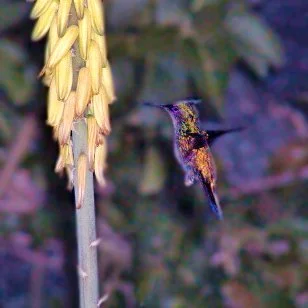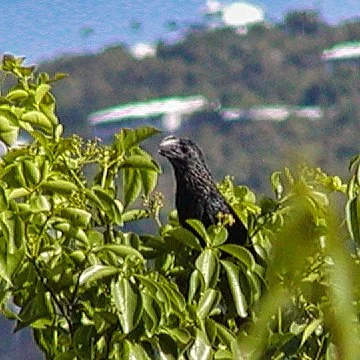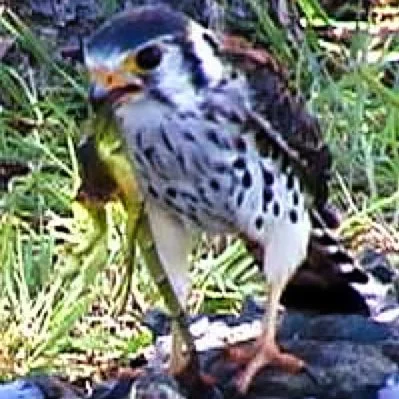Brown-Throated Conure (Aratinga pertinax)
Also called the brown-throated parakeet, the brown-throated conure is a small member of the parrot family. It is native to Panama, northern South America and adjacent islands. This species was introduced to the Virgin Islands by being brought from Curacao to St. Thomas.
Conures feed on fruits and seeds from a variety of trees and shrubs. The birds nest colonially in active termite nests or cavities in trees. They travel in pairs or small flocks, often communicating with loud calls and squawks.
Bananaquit (Coereba flaveola)
Bananaquits are found in virtually every habitat in the Virgin Islands. They are also known as yellow-breasts or sugar birds.
They eat a wide variety of foods, including plant nectar, fruits and insects. They are frequent visitors to hummingbird feeders and even enter homes to take sugar or food scraps from the table.
Bananaquits live in pairs and build oval shaped nests. They typically lay two to three eggs per clutch. Hatching occurs after about 12-14 days. Bananaquits also frequently construct separate nests used for roosting. These nests are smaller and not quite as sturdy as nests intended for rearing young.
Green-Throated Carib (Sericotes holosericeus)
The green-throated carib is a common hummingbird in the Virgin Islands. These small fast birds pollinate plants by zipping from flower to flower to drink nectar. Hummingbirds often visit a series of flowers in a specific sequence in order to give the plants time to replenish their nectar supply. They can be quite aggressive when defending their feeding territories, including hummingbird feeders.
Female green-throated caribs are slightly smaller than males, but have a longer and more curved bill. A patient observer may be lucky enough to observe a green-throated carib repeatedly extending its long tongue from its beak while resting on a branch.
Antillean Crested Hummingbird (Orthorhyncus cristatus)
Also know as the doctorbird, the antillean crested hummingbird is a tiny bird that weighs just a fraction of an ounce. The doctorbird has a short strait bill and a crest of feathers on top of the head. Males and females appear similar, but the crest can be more pronounced in the male and males tend to have darker underparts.
Photo: S. Smollett
Like the green-throated carib and other hummingbirds, these small hummingbirds pollinate plants by visiting flowers to feed on nectar. They also include small insects in their diet.
Doctorbirds breed all year round, but mainly in the spring and summer. A diligent observer may be lucky enough to observe their small cup-shaped nest built on thin branches or vines about three to six feet off the ground.
Doctorbird visiting an aloe flower
Gray Kingbird (Tyrannus dominicensis)
The gray kingbird is a common bird in the Virgin Islands. It is very easy to observe since it frequently perches on exposed branches during the day and makes a high-pitched call.
The gray kingbird belongs to a group of birds called “flycatchers.” As the name implies, a kingbird feeds mostly by darting from its perch to catch flying insects. Kingbirds also sometimes feed on berries and large seeds.
Pearly-Eyed Thrasher (Margarops fuscatus)
Pearly-eyed thrashers are another common bird that are easily observed. However, getting a thorough look at a thrasher may be difficult, as the birds make good use of their color camouflage and hide amongst plants and tree branches.
Pearly-eyed thrashers can be easily recognized by the whitish eye surrounding a dark pupil. They make loud distinctive calls.
Thrashers eat a variety of fruits, berries, insects and small animals. The one in the picture was eating the fruits of a Christmas palm. Thrashers aggressively compete with other birds for nest space, and may eat the eggs of other species, including brown-throated conures.
Smooth-Billed Ani (Crotophaga ani)
Sometimes called the black witch, the smooth-billed ani can be surrounded by superstition. According to the folklore of some Virgin Islanders, an appearance by an ani can be the harbinger of a death in the family. Typically, anis are uncommon in the areas where this belief is held.
These coal black birds nest communally, with several females laying eggs in a single nest. Smooth-billed anis can sometimes be seen removing ticks from cattle and other livestock.
Kestrel (Falco sparverius)
The kestrel is a commonly seen bird of prey in the Virgin Islands. These falcons are easily recognized by their small size and distinctive facial pattern.
They feed upon other birds, rats, mice, lizards, snakes and possibly small mongoose. The pictured kestrel is making a meal of a juvenile green iguana.
Kestrels have vision that is about eight times as acute as that of humans. They use this keen sight to hunt and capture prey.
Zenaida Dove (Zenaida aurita)
Also called wood doves and mountain doves, zenaida doves are easily observed. They can reach a total length of about 12 inches.
These doves can often be seen walking on the ground feeding on seeds and occasionally fruit. The also frequently perch on trees and wires. Their gentle cooing provides a musical backdrop to the day.
Zenaida doves mainly breed between February and August, laying two white eggs. They build their nests in trees and occasionally on the ground.
Scaly-Naped Pigeon (Patagioenas squamosa)
The soft coos of scaly-naped pigeons provide relaxing background music that invokes a chill atmosphere - especially in areas where the birds are abundant. Since they tend to perch high in trees (usually behind something that obscures the view), they are more likely to be heard than clearly seen. Often, they announce their presence with a loud flapping of wings as they take flight.
These pigeons get their name from the scaly appearance of the feathers on their napes. They feed on seeds and fruits from a variety of trees. The pigeons mainly nest in trees and lay one to two white eggs.
Great Egret (Ardea alba)
With its large size and snowy white plumage, the great egret is a dramatic sight. These large birds can stand to over 3 feet high and can have wingspans of over 5 feet. They can be found in a variety of areas, including roadsides, parking lots, beaches, and salt ponds. They nest in colonies in trees near bodies of water.
Great egret holding a fish in its beak
Photo: S. Smollett
Great egrets eat a variety of foods. They forage in shallow water for fish, frogs and crustaceans. The also search for food on land and have been known to eat insects, mice, and small reptiles.
Great egret taking flight
Photo: S. Smollett
Bahama Duck (Anas bahamensis)
Bahama ducks are small ducks that can be found in coastal lagoons, mangrove swamps, salt ponds and freshwater ponds and lakes. Bahama ducks feed on plants and insects in shallow waters by dunking their heads and tipping their tails in the air.
During courtship, males make subdued honking calls and shake their bodies. Bahama ducks are also known as white-cheeked pintails.
Common Moorhen (Gallinula chloropus)
Moorhens are very attractive birds that are fun to watch. They are clearly distinguished by their colorful markings, long yellow legs and large feet. They can be found in freshwater ponds and marshes.
Moorhens eat a wide variety of foods including insects, frogs, fish, snails, spiders, seeds and the leaves and fruits of aquatic plants.














